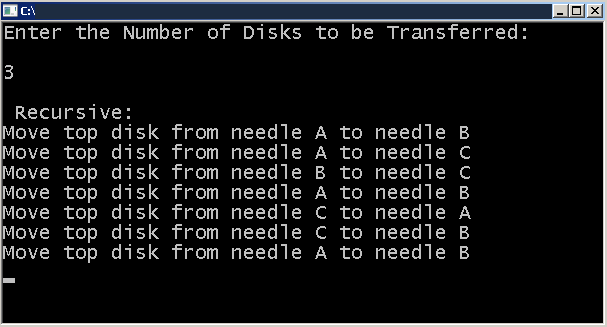The Tower of Hanoi is an interesting recurrence relation problem. In this example, you will write a program to solve the Tower of Hanoi using a recursive function.
Before you begin, learn basics of C programming language, if you the basics skip this step and continue reading.
Problem Definition
Suppose you are given 3 disks of different size and 3 pegs. Each peg is labeled – A, B and C and smaller disk is always place on top of larger disks. The peg A has all three disks and your task is to move all the disks to the peg C. But there are rules to move disk between pegs.
- You can move only one disk at a time.
- You cannot place a larger disk on top of smaller disk.
- You should solve the problem with minimum disk movements.
If the solution is achieved in 10 steps, a 12 step solution is not acceptable by rule 3.
Learn more about Tower of Hanoi in the following article.
In this example, a recursive method is used to solve the Tower of Hanoi problem.
Program Source Code
#include <stdio.h>
#include <stdlib.h>
void hanoirecursion(int num,char ndl1, char ndl2, char ndl3)
{
if(num == 1)
{
printf("Move top disk from needle %c to needle %c\n",ndl1,ndl2);
return;
}
hanoirecursion(num-1,ndl1,ndl3,ndl2);
printf("Move top disk from needle %c to needle %c\n",ndl1,ndl2);
hanoirecursion(num-1,ndl3,ndl2,ndl1);
}
int main()
{
int no;
printf("Enter the Number of Disks to be Transferred:\n\n");
scanf("%d",&no);
if(no<1)
{
printf("\n There is nothing to move:\n");
}
else
{
printf("\n Recursive:\n");
hanoirecursion(no,'A','B','C');
}
getch();
return 0;
}Output

Related Articles: –
- C Program to Reverse a Number using Recursion.
- C Program to Compute Nth Factorial using Recursion.
- C Program to Compute Nth Fibonacci Number.
- C Program to Manipulate Matrices.